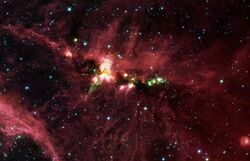Astronomy:DR 21
| Molecular cloud | |
|---|---|
 Infrared view of the DR 21 molecular cloud | |
| Observation data: J2000 epoch | |
| Subtype | Emission nebula |
| Right ascension | 20h 39m 01.6s |
| Declination | +42° 19′ 38″ |
| Distance | 6,000 ly (1,800 pc) |
| Constellation | Cygnus |
| Designations | GRS G081.70 +00.50, GAL 081.681+00.54, W 75, 18P 78, 36P 19, RAFGL 2624 |
DR 21 is a large molecular cloud[1] located in the constellation Cygnus, discovered in 1966 as a radio continuum source by Downes and Rinehart.[2] DR 21 is located about 6,000 light-years (1,800 pc) from Earth and extends for 80 light-years (25 pc).[3] The region contains a high rate of star formation and is associated with the Cygnus X star forming region. It has an estimated mass of 1,000,000 M☉.[4]
A number of different molecules have been detected in the region by their radio emission, including formaldehyde, ammonia, water and carbon monoxide.[5]
In this region, some of the most massive stars in the Milky Way have been observed. DR 21 contains complex patterns of dust and gas, which glow in the infrared due to the presence of organic compounds known as polycyclic aromatic hydrocarbons. Jagged patterns within DR 21 result from interactions with interstellar wind, radiation pressure, magnetic fields, and gravity.[6]
An estimated population of 2,900 stars have been formed in this molecular cloud, similar to the population of the Orion Nebula cluster, which are distributed in groups associated with cloud clumps.[7] Feedback from the massive stars may ultimately disrupt the cloud, however this has not yet happened due to the region's extreme youth. Study of these stars by the Spitzer Space Telescope has shown signs of protoplanetary disks.[8]
References
- ↑ Nadeau, Daniel; Beland, Stephane (January 1988). "Observations of the line profiles of H2 in the DR 21 molecular cloud". The Astronomical Journal 95: 136–140. doi:10.1086/114621. Bibcode: 1988AJ.....95..136N.
- ↑ Downes, D.; Rinehart, R. (June 1966). "Microwave Observations of the Cygnus X Region". The Astrophysical Journal 144: 937. doi:10.1086/148691. Bibcode: 1966ApJ...144..937D.
- ↑ Rees, Martin J., ed (October 2012). Universe: The Definitive Visual Guide. New York: Dorling Kindersley. p. 246. ISBN 978-0-7566-9841-6. https://books.google.com/books?id=CqrWEBWPfYoC&pg=PA246.
- ↑ Wilson, T. L.; Mauersberger, R. (November 1990). "The Internal Structure of Molecular Clouds. I. C18O, C34S and NH3 Maps of the DR 21/W 75 S Region". Astronomy and Astrophysics 239 (1–2): 305–318. Bibcode: 1990A&A...239..305W.
- ↑ Langston, Glen (2001). "DR21: Star Forming Region in Constellation Cygnus". National Radio Astronomy Observatory. http://www.gb.nrao.edu/~glangsto/dr21/.
- ↑ Lai, Shih-Ping; Girart, José M.; Crutcher, Richard M. (November 2003). "Interferometric Mapping of Magnetic Fields in Star-forming Regions. III. Dust and CO Polarization in DR 21(OH)". The Astrophysical Journal 598 (1): 392–399. doi:10.1086/378769. Bibcode: 2003ApJ...598..392L.
- ↑ Kuhn, Michael A.; Getman, Konstantin V.; Feigelson, Eric D. (March 2015). "The Spatial Structure of Young Stellar Clusters. II. Total Young Stellar Populations". The Astrophysical Journal 802 (1): 60. doi:10.1088/0004-637X/802/1/60. Bibcode: 2015ApJ...802...60K.
- ↑ Povich, Matthew S.; Kuhn, Michael A.; Getman, Konstantin V.; Busk, Heather A.; Feigelson, Eric D. et al. (December 2013). "The MYStIX Infrared-Excess Source Catalog". The Astrophysical Journal Supplement 209 (2): 31. doi:10.1088/0067-0049/209/2/31. Bibcode: 2013ApJS..209...31P.
External links
- DR 21 at SIMBAD
- "Invisible Giants Exposed in New Spitzer Image" by NASA/Jet Propulsion Laboratory
- "Star Formation in the DR21 Region (B)" by NASA/Jet Propulsion Laboratory
- NASA Astronomy Picture of the Day: Massive Star Forming Region DR21 in Infrared (14 April 2004)
 |

